This is the fourth part in a series on the intersections of technical communication in the tech industry and the academy. Read the series introduction here.
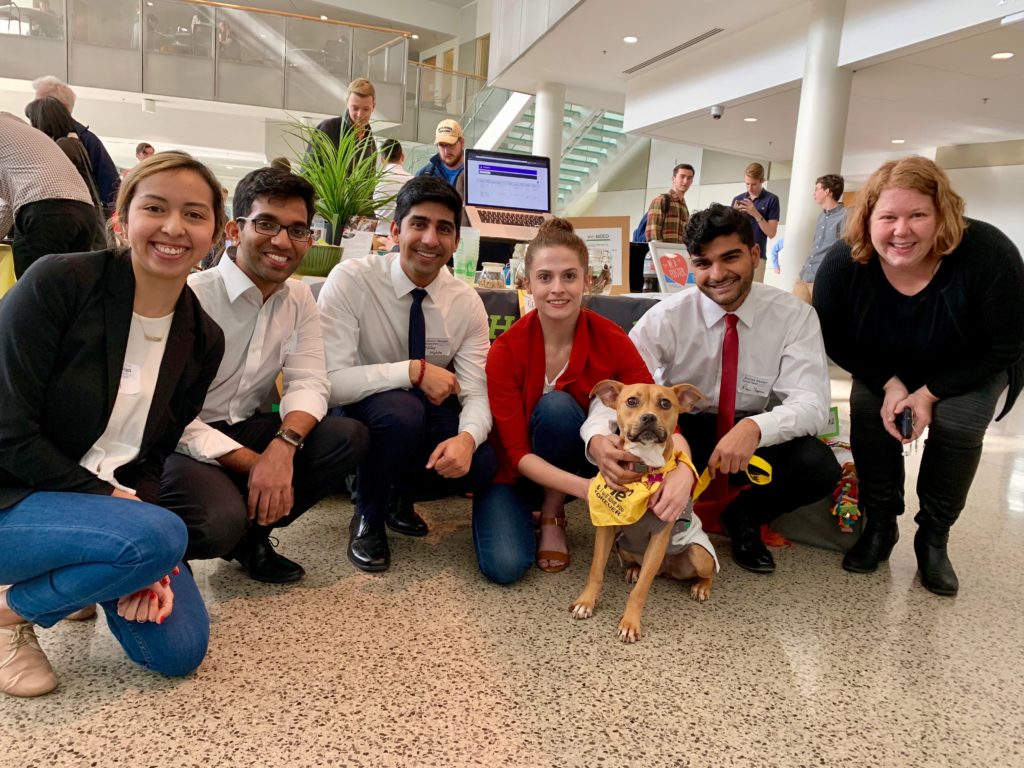
Team 8122 poses with Fiona, a pup up for adoption through their client, Laskey’s Lucky Ones, at Georgia Tech’s Fall 2018 Computer Science Junior Design Expo
When I gave a talk at Monktoberfest 2018 on my experiences teaching Computer Science Tech Comm at Georgia Tech, I was delighted to see such enthusiastic reactions to the public exposition assignment we use in the course.
Because the expo assignment (and the accompanying event that we organize to showcase the results) is a relatively new addition to the CS Tech Comm course sequence, it is worth a look into the types of events the assignment emulates, the considerations that went into developing the assignment, and the deliverables that our student teams are expected to develop.
Tech Conferences and Public Expos
Public expositions are staples at larger tech conferences. Participants in such expos often have varying motivations. Vendors attend primarily to generate interest in their tech, collect information for outbound marketing (often through a system by which attendees allow vendors to scan their conference badges), spark potential sales, and even recruit new talent. Expo attendees will often find themselves on an expo floor in between sessions, keynotes, and meals, as it offers them an opportunity to check out related tech from new vendors and new tech from established vendors.
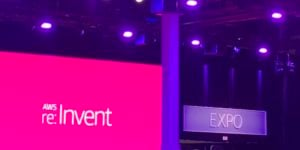
Expo booth fees can be steep, with the larger booth spaces at some conferences costing upwards of $100k. Because vendor booths are competing for the time and attention of expo attendees, vendors must be strategic about how they stage and staff expo booths. Staging can involve banners, monitors, demos, and swag; staffing can vary from sales and marketing personnel to executives to technical resources.
When software developers attend tech conferences, their motivation is usually to give talks; attend conference sessions, keynotes, and social events; and participate in certifications or hackathons. However, company support for developer attendance at such conferences is often made contingent on pulling “booth duty” for their company at the public expo, as most successful booths have technical resources on hand to engage technically-inclined expo attendees.
The ability to successfully help staff an expo booth therefore can determine support for conference attendance, which in itself can help shape the career paths of software developers. The public-facing technical communication skills required for booth duty can also help open avenues to additional technical roles such as technical marketing, sales engineering, and even developer relations. For developers who hope to someday found their own companies, such skills can even make or break a business.
Adapting the Expo Experience for the Classroom
In Spring 2018, Georgia Tech introduced a public exposition component into its CS Tech Comm & Junior Design course sequence, which is aimed at students who are likely to work in the software industry. As I have outlined in a previous post, this course sequence has student teams design and implement a software project (often with a real-world client) over two semesters while also completing corresponding tech comm deliverables.
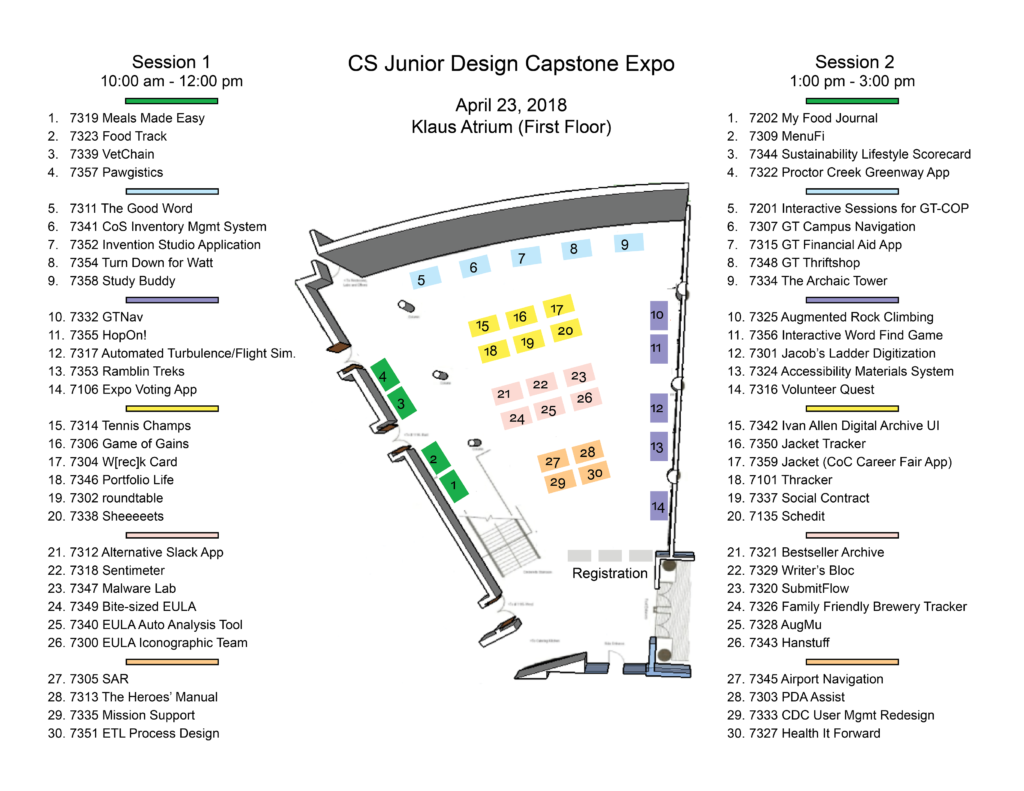
Prior to the introduction of the expo assignment, student teams finished the second semester of the course sequence with an in-class group presentation. While clients were invited to attend, they rarely did so. Presentation requirements included a verbal introduction to the project, a demonstration of the completed software, and accompanying visual aids such as slides. While there were many advantages to this assignment, students complete a similar presentation at the end of the first semester of the course sequence. Disadvantages of the repeating the assignment at the end of the second semester included 1) lack of client attendance 2) no public visibility 3) repetition of a communicative form already experienced.
In seeking out alternatives, my colleagues and I took a look at some of the other events designed to showcase student work on the Georgia Tech campus. While Georgia Tech holds a Capstone Design Expo, the College of Computing does not participate in this event for a number of reasons. First, the structure of the courses that participate in the event requires teams to charge clients. Second, the event is based on courses that follow a single-semester capstone model (whereas the CS Tech Comm & Junior Design course sequence was designed explicitly to span two semesters). Third, the presentation poster and demo format used for the event does not align with the types of booth setups common at software industry events.
We also did research into what other computer science programs did in terms of public-facing tech comm skills. Our research indicated that presentations are a common feature of computer science capstone courses, with objectives as diverse as soliciting formative peer feedback, serving as an oral defense of project deliverables, and celebrating student work [1]. Types of presentations range from short in-class progress updates to longer, formal in-class presentations to public product demonstrations. Some research [2] argues that public “tech show” style presentations are the most effective “in improving student learning in synthesis, organization, prioritization, and articulation” (426), but indicated problems with deliverable forms such as posters. Our research also found that class assignments that require students to address the needs of various audiences are more effective at translating to communication practices in the workplace [3]. Because the tech show style of presentation also requires students to imagine scenarios and audiences they are likely to encounter in a variety of software industry jobs, an assignment based on a tech show/public expo style presentation was deemed the best course of action.
Based on our findings, in Spring 2018 we decided to stage a public capstone exposition specifically for the teams in the CS Tech Comm & Junior Design course sequence, which would require students to produce a set of deliverables specifically intended for public consumption. Our pedagogical goals included:
- Help students develop additional technical communication skills specific to software industry events such as tech shows, tech conferences, expos, and recruitment fairs.
- Familiarize students with the processes and deliverables associated with such events.
- Ensure that deliverables reflected materials common to software industry events rather than those common to academic events (such as posters).
- Provide a public venue where clients, instructors, administrators, and students can experience and celebrate the work done by our students.
- Increase the visibility of the course sequence and recruit future project clients.
The Spring 2018 CS Junior Design Capstone Expo (as we called it), included 60 student teams, each of which was assigned to a 2-hour expo session. For the Fall 2018 Expo we had 42 student teams (resulting in a less crowded afternoon session).
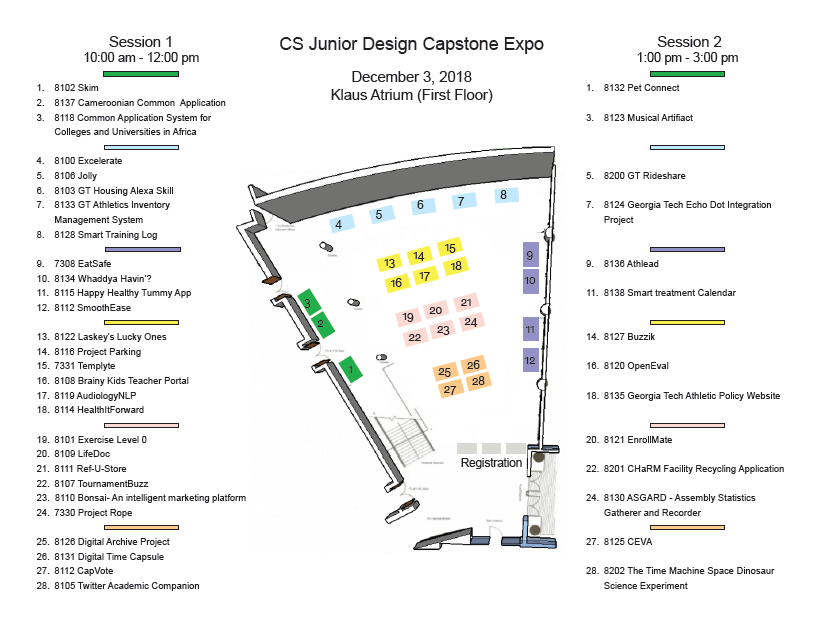
A breakdown of the assignment deliverables, along with examples from both the Spring and Fall 2018 events, are included in the next section.
Assignment Deliverables

Expo assignment deliverables include elements such as table staging and distributable collateral that are specific to exposition formats, as well as suitably modified demonstration requirements. Student teams are expected to carefully consider the potential audiences for each deliverable, as the background and technical expertise of Expo attendees can vary greatly. Attendees include computer science and computational media majors taking the first part of the course (who are required to attend in order to get a better sense of what they can expect from the second part of the course sequence) as well as members of student teams presenting at the expo who are not currently on booth duty. It is also common for course instructors from both parts of the course sequence to attend (even when they do not have teams to grade), along with course coordinators, administrators, and members of the larger Georgia Tech community. Because the event is free and open to the public, students sometimes invite friends and family; we also see potential Georgia Tech students stop in as part of their campus tour.
We are, of course, delighted when project clients are able to attend the event. Expo organizers send formal invitations to all project clients, and instructors encourage student teams to invite their clients directly as part of good client communication practices.

Table Staging
Deliverable objective: draw expo attendees to your team’s booth.
The expo is typically held in the atrium of the Klaus Advanced Computing Building on the Georgia Tech campus. Each team is assigned a 6-foot x 2.5-foot table and given access to chairs, a power strip, and the campus wi-fi (although they are instructed to be prepared for both wi-fi and power issues by bringing a local demo and charged laptop).
Staging and staffing requirements:
- Teams are expected to staff their table with 1-2 team members for the entirety of their assigned 2-hour session.
- Attire must be appropriate for the event (and level of formality should be coordinated among all team members present).
- Table setup must accommodate all print collateral, demo equipment, and team staffing.
- Table staging should enhance product and team branding and maintain a professional ethos.
Teams are also allowed to include additional items such as tri-fold posters, monitors, swag, banners, and tablecloths, but are cautioned to ensure that such items do not detract or distract from their presentation. In some cases, clients help supply teams with materials for the expo and even attend to help promote their team’s project and their own organization. We have also been lucky enough to recruit project clients who help promote the expo itself.
Happening now in the @GeorgiaTech Klaus Atrium: the Computer Science-Tech Comm Junior Capstone Expo! Come by and see the amazing projects the students have coded for clients over the past year (including one for grading Twitter they built for me!) @gtcomputing @brittainfellows pic.twitter.com/fOUN8W6LkR
— Dr Rebekah Fitzsimmons (@DrFitzPhD) December 3, 2018
Elevator Pitch
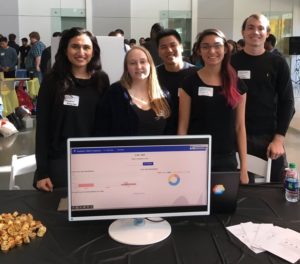
Deliverable objective: engage your audience with a brief description of your project.
Once a team’s table staging has effectively drawn in an audience, a team member delivers an elevator pitch designed to generate enough interest in the project that the audience is willing to watch a demo. The pitch must be concise enough to achieve this in a very brief period (about the length of a typical elevator ride). Elevator pitches should be scripted ahead of time and rehearsed, as student teams can expect to deliver it many times throughout a single Expo session. The pitch should also be geared towards a non-technical audience.
Elevator Pitch Requirements:
- Deliver the pitch within the time requirement of 20-30 seconds.
- Tell a story that conveys the project’s key value proposition.
- Follow a clear, logical structure that includes a beginning, middle, and an end.
- Use word choice and tone appropriate for the content and audience.
- Body language should convey confidence (steady posture and hands) and engagement with the audience (steady eye contact).
- Speaker should use consistent and effective voice quality (for example, tempo, inflection, enunciation, and audibleness).
Initial Demo Segment
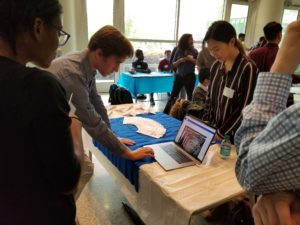
Deliverable objective: demonstrate the most interesting/important/fascinating features of your project to a non-specialist audience.
After a successful elevator pitch—a pitch that entices someone to stay with a project beyond the initial 30 seconds—a team member transitions to a short initial demo of the project itself. For this demo, teams showcase the most important (or interesting or groundbreaking) project features. While live demos are encouraged, recorded demos may be necessary for projects that have dependencies (cars, animals, remote hardware) that cannot be accommodated at the Expo. This demo should take no more than 2 minutes and 30 seconds.
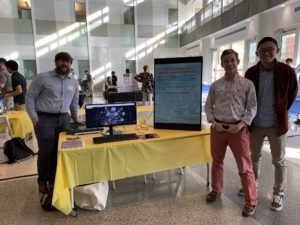
Although student teams are only graded on this short, initial demo, if this demo segment is effective, their audience will to stay beyond the initial demo segment to see more of the project. For this reason, teams are encouraged to prepare for a second or third communicative “segment” of more elaborate, in-depth demos. When possible, we ask teams to consider allowing audience members to work with your product themselves.
Demonstration Requirements:
- Time: no longer than 2 minutes 30 seconds.
- Selection of key features/user tasks: Demonstrate key features and tasks relevant to the audience, with a focus on ensuring your demo is coherent. If you are not able to demo all parts of your project (which is likely, given time constraints), choose the pieces that are most important and most engaging. Consider glossing over redundant or overly familiar information (such as login).
- Organization strategy: All aspects of organization need to be carefully thought out, including: how you sequence the steps of the demo; how you choose to contextualize your chosen demo piece; how you deliver the demonstration (i.e., laptop, tablet, live site/app)
- Questions: Team members should be prepared to field questions about your project.
Distributable Collateral
Deliverable objective: provide project and team information in a format that your audience can take away with them.
Regardless of whether or not an attendee stays for a team’s elevator pitch or demo, it is always good practice to give them the option of leaving with a piece of printed collateral that effectively represents the project and team. Notably, teams are required to include a problem statement and product position on their distributable collateral.
Distributable Collateral Requirements:
- Materials should take the form of a brochure, handout, or other printed distributable format approved by your instructors.
- Follow principles of good document design and technical communication.
- Include a brief problem statement and product position.
- Explain key features and how they support the product position/provide a solution to the problem statement.
- Include team number and project name info, as well as the names of all team members.
Examples of Distributable Collateral:
Postcard design for Team 8500’s Family Friendly Brewer Trackr (front and back):

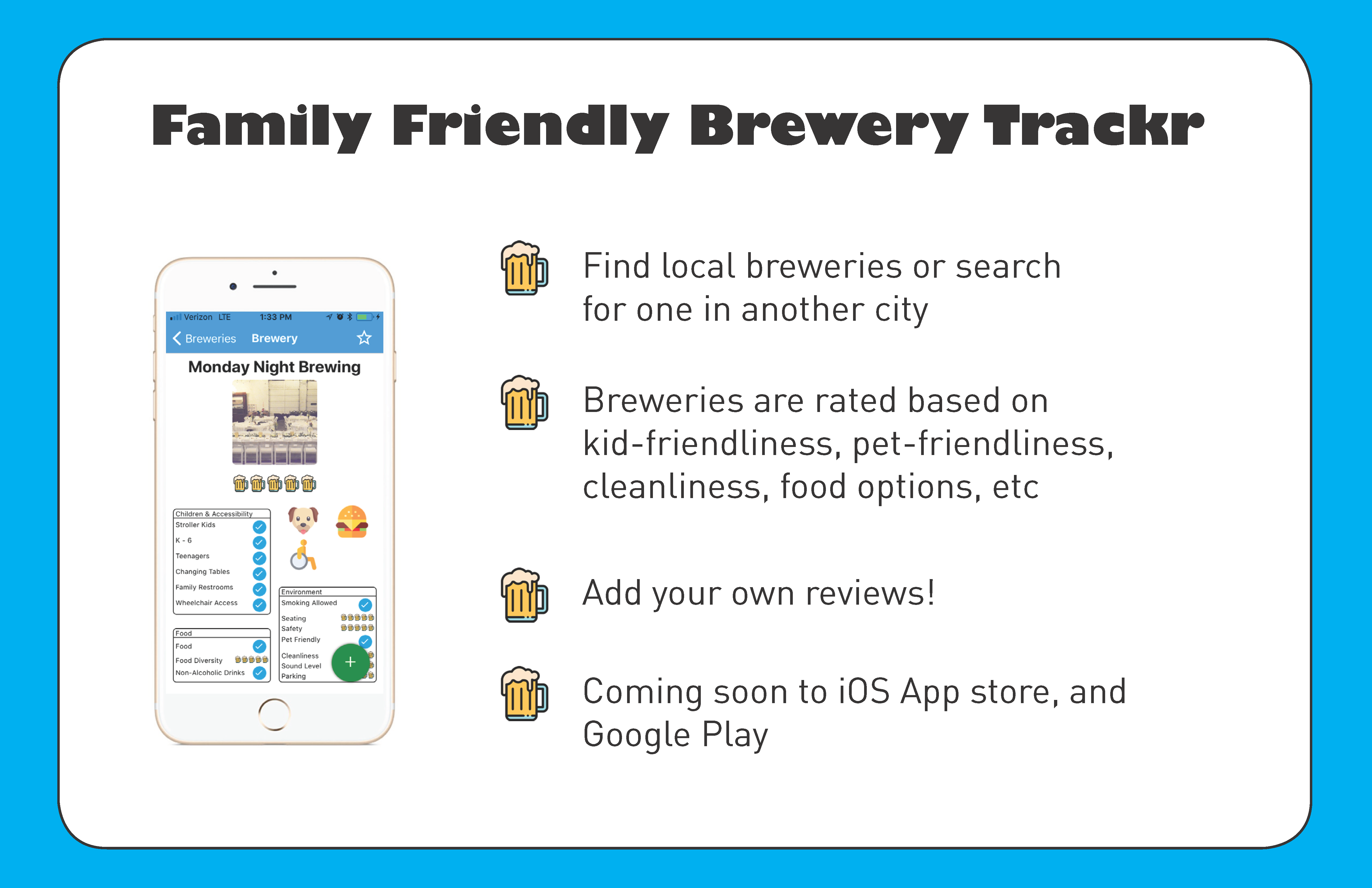
Tri-fold brochure design for an Omeka plugin created by Team 7342 for the Ivan Allen Digital Archive:
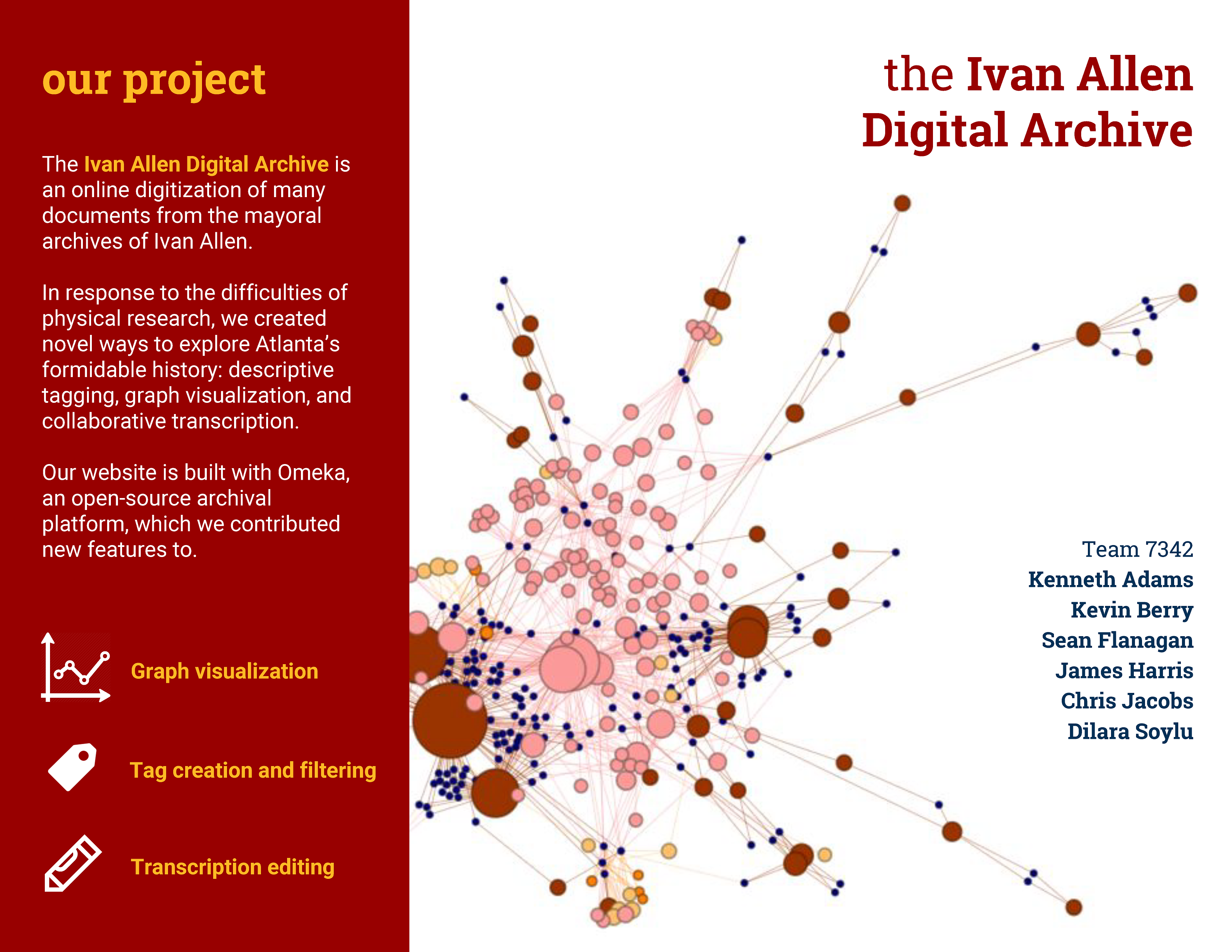
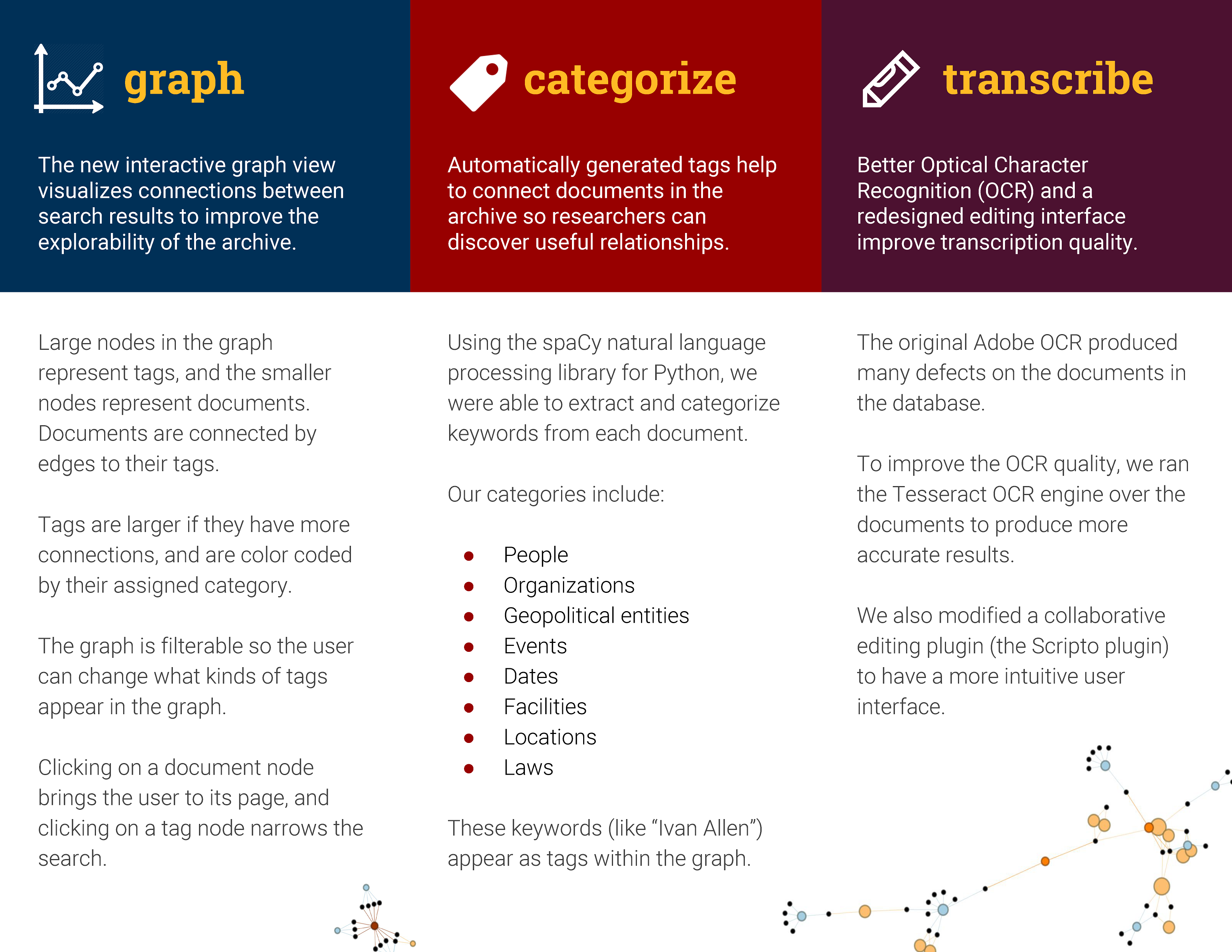
Note for Potential Project Clients
With up to 60 student teams beginning new projects each semester, we are always on the lookout for suitable projects and clients. If you have a project that you think might be a good fit and are interested in serving as a project client for one or more student teams, please contact Olufisayo Omojokun at [email protected].
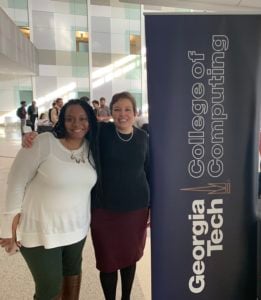
Acknowledgments
- Sarah Lozier-Laiola and I developed the initial Expo assignment and coordinated the inaugural Expo in Spring 2018 with input from computer science instructors Robert Waters, Olufisayo Omojokun, and Mary Hudachek-Buswell. Cedric Stallworth, Assistant Dean for Outreach, Enrollment and Community, also advised on the event venue and schedule; his office continues to provide financial and staffing support for the event.
- Event planning and coordination for the Spring 2018 and Fall 2018 Expos was largely directed by Alyshia Jackson, Administrative Professional Sr. in the College of Computing’s Office of Outreach, Enrollment and Community.
- Amanda Girard helped coordinate the Fall 2018 Expo, and, along with Alyshia Jackson, has taken over coordination of the Spring 2019 Expo.
References
[1] R. F. Dugan Jr., “A survey of computer science capstone course literature,” Computer Science Education, vol. 21, no. 3, pp. 201-267, 2011.
[2] C. Liu, “Software project demonstrations as not only an assessment tool but also a learning tool,” ACM SIGCSE Bulletin, vol. 38, no. 1, pp. 423-427, 2006.
[3] M. C. Paretti, “Audience awareness: Leveraging problem-based learning to teach workplace communication practices,” IEEE Transactions on Professional Communication, vol. 49, no. 2, pp. 189-198, 2006.
Note: a version of this article has also been published on TECHStyle.
Disclaimer: AWS is a RedMonk client.
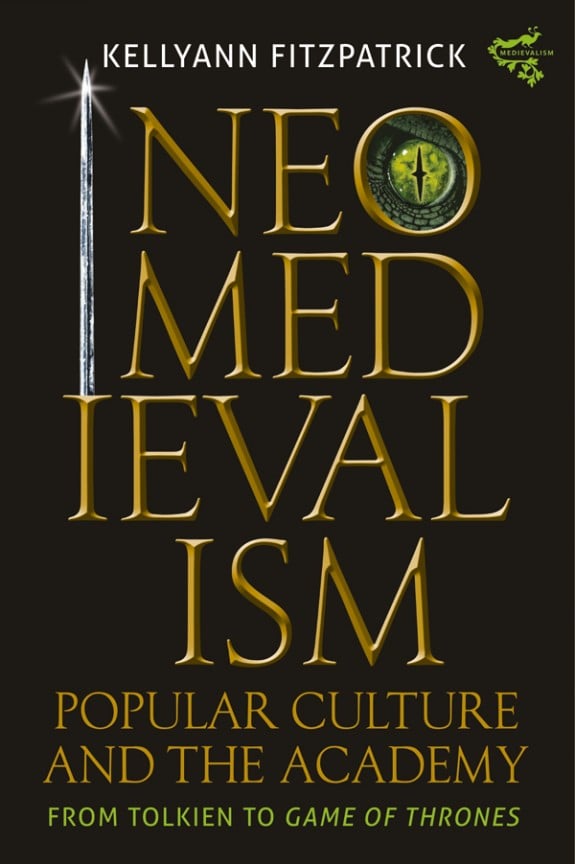
No Comments